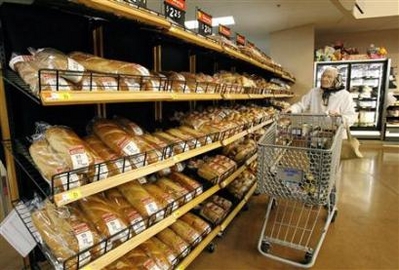Shoppers scrimp as food prices rise in US
Updated: 2008-04-04 18:39
SECAUCUS - Patricia Norris' family is feeling the one-two punch of higher fuel and food prices.
|
A shopper browses the bread section at a Wal-Mart store in Santa Clarita, California April 1, 2008. [Agencies] |
Her husband works as messenger, driving around to deliver packages. But the job is not as profitable as it once was because rising fuel prices are eating into his earnings.
With money tight and food prices rising, Norris can no longer afford to buy beef and chicken on a regular basis.
"We buy meat only for special occasions. Like for Easter, we had a ham," she said after a shopping trip at her local Wal-Mart in Romeoville, a mixed blue- and white-collar suburb of Chicago.
Norris must purchase only what is on her shopping list, to avoid spending more than she can afford.
Across the United States, consumers like Norris are finding that grocery shopping has become a sobering experience as their budgets fail to keep pace with food costs.
Reuters reporters visited Wal-Mart stores in Romeoville, Illinois, Secaucus, New Jersey and Santa Clarita, California, on the last day of March and the first day of April to find out how shoppers are navigating the food aisles when they have payday cash in their pockets.
Already squeezed by high gasoline prices, slumping home values, a weakening job market and the possibility that the US economy is in a recession, consumers have adopted a no-nonsense approach to shopping, passing over a trip to Target or a local grocery store if they can find lower prices at Wal-Mart.
They are buying cheaper store-brand products, avoiding costly cuts of meat, consolidating trips, clipping coupons, constructing well-researched shopping lists and avoiding splurges to spend only the bare minimum.
"I don't buy anything I don't have to," Norris said.
Food prices jump most in 17 years
US consumer food prices normally rise by about 2.5 percent annually, but they increased by 4 percent in 2007 -- the biggest increase in 17 years, according to US Agriculture Department data.
|
||
|
||
|
|
|
|








